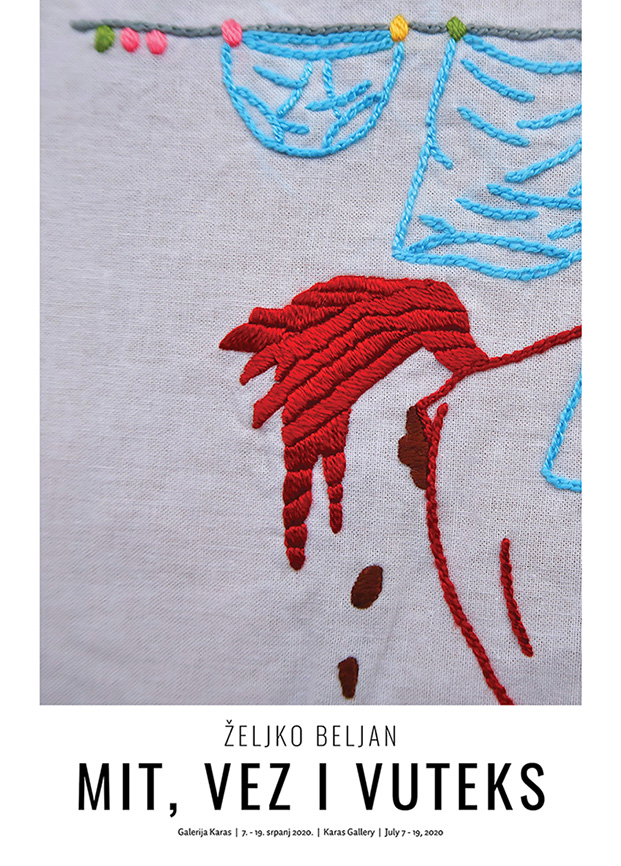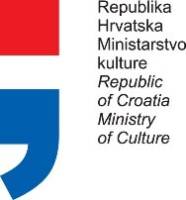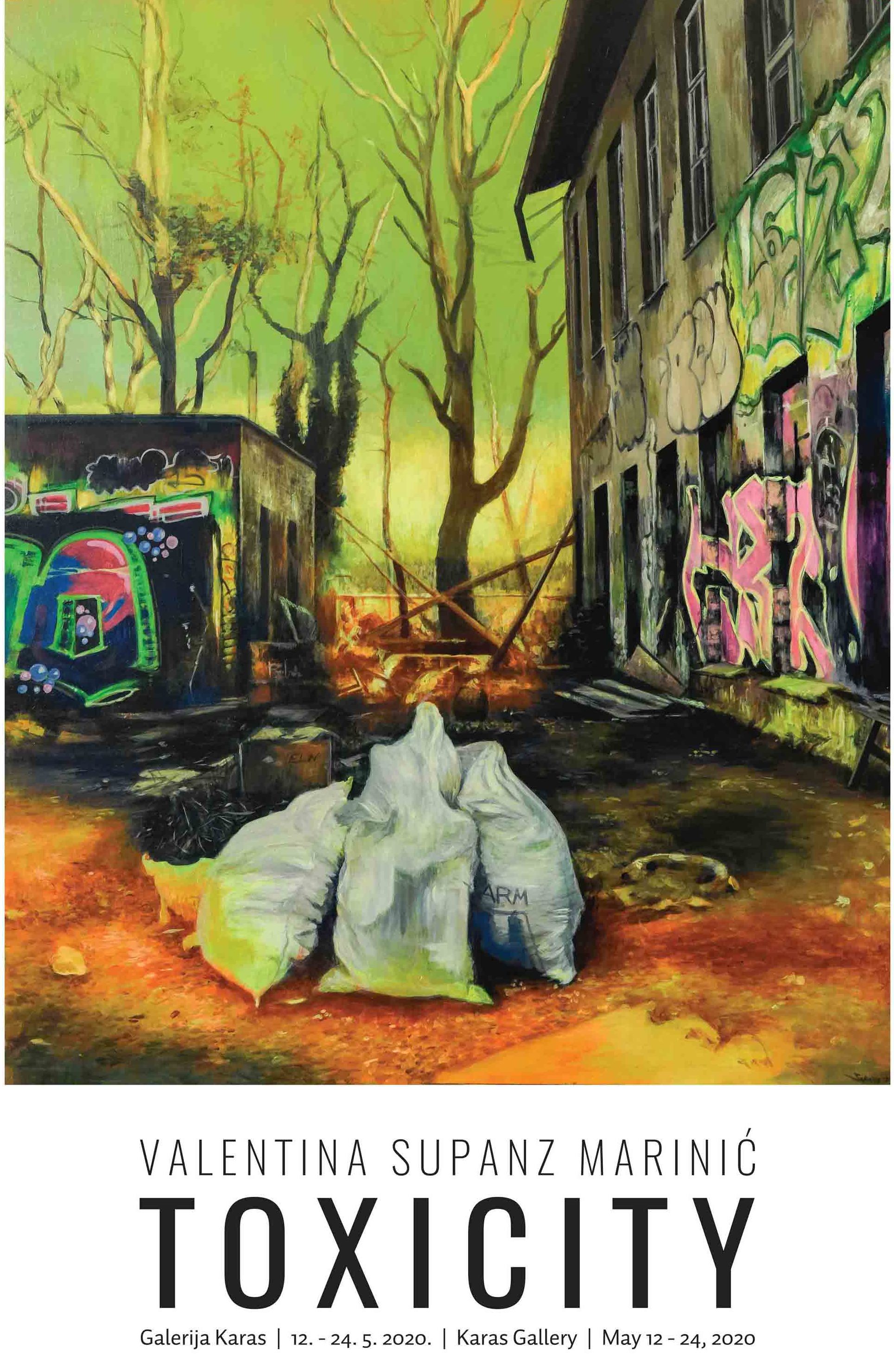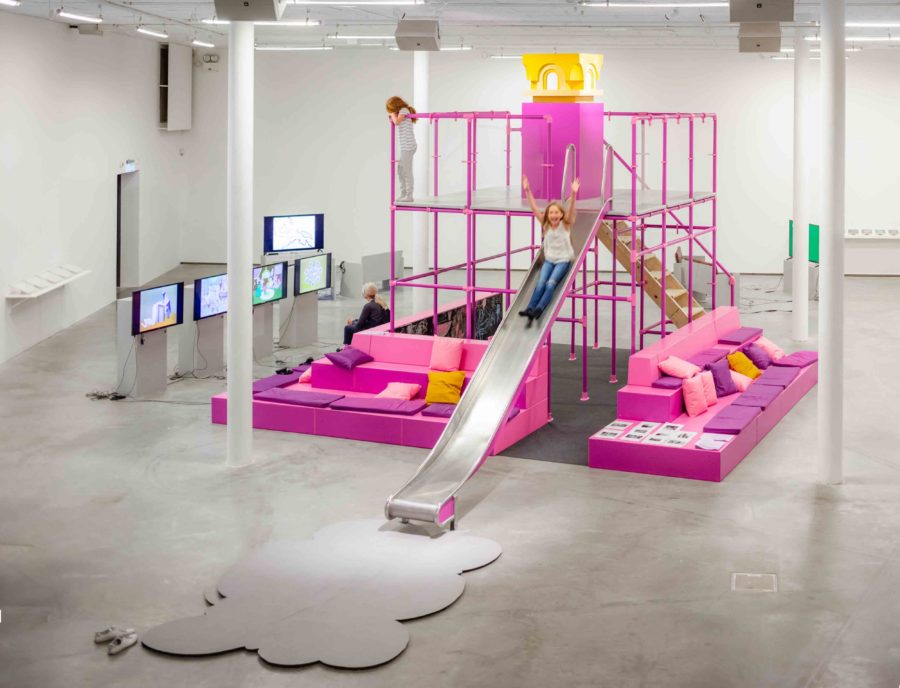Category: Exhibitions
ŽELJKO BELJAN
MYTH, EMBROIDERY AND VUTEKS
Karas Gallery, Kralja Zvonimira 58
July 7– July 19, 2020

Following all recommendations of the National Civil Protection Headquarters, exhibition MYTH, EMBROIDERY AND VUTEKS, by Željko Beljan, will be opened on Tuesday, July 7 at 7 pm at the Karas Gallery (Kralja Zvonimira 58).
(…) “The embroidery motifs have been changed in Beljan’s alternate reality, they are no longer meant for idyllic kitchens or ethnographic collections in heritage museums, but for the artist’s personal ritual in which he, like a shaman, liberates his own past and changes its course. Just as Saša Božić and Petra Hrašćanec play with the choreographies of folk dance groups in the dance performance Kolo (The Circle Dance) (2019), creating an almost futuristic traditional performance, Željko Beljan also takes us to the psychedelic sky, the same one where we will share a messianic vision with pigs, dolphins, and ducks. In this sky, everything is truly possible in a simultaneous reality. ”
From the preface, written by Josip Zanki
ABOUT THE ARTIST
Željko Beljan was born on June 17, 1984, in Vukovar. Since 2016, he has been studying at the Department of Animated Film and New Media of the Academy of Fine Arts in Zagreb. He has been engaged in illustration, comics, and poster production since 2010. He had his first solo exhibition in 2016 in Osijek. He is the author of numerous posters for various Zagreb clubs and other artistic initiatives and bands of which he is a member or associate.
Organizer:

Supported by:


Working hours:
Wednesday – Friday: 3 pm – 8 pm | Saturday: 10 am to 1 pm
Sundays, Mondays, Tuesdays and holidays: closed.
The exhibition will remain open until July 19, 2020
*Remark*
At the entrance to the Gallery there is a bottle with a disinfectant for visitors, which are obliged to disinfect their hands when entering the Gallery.
The security guard at the entrance to the Gallery will have a protective mask and gloves and control the number of visitors. The Gallery can hold up to 5 people at a time.
Visitors are required to maintain a distance of 2 meters.
Touching the exhibits is not allowed.
Doorknobs and any other surfaces that are frequently touched by visitors will be regularly disinfected.
KARLA ČURČINSKI AND LAURA MARTINOVIĆ
THE EFFORT OF INFINITY. I’M AFRAID TO DREAM
Karas Gallery, Kralja Zvonimira 58
June 23– July 5, 2020

Following all recommendations of the National Civil Protection Headquarters, exhibition THE EFFORT OF INFINITY. I’M AFRAID TO DREAM, by Karla Čurčinski and Laura Martinović, will be opened on Tuesday, June 23 at 7 pm at the Karas Gallery (Kralja Zvonimira 58).
ARTISTS´ STATEMENT
Through artworks on the topic of The effort of infinity, I fear to dream we question the current issues of culture in society, the form of cultural institutions and its society, and the limits of failure, success, and artist’s motivation. We present our own experiences and through the synonym of the bad in these situations, we create cultural symbols that are a reflection of the expected and known result.
We place great emphasis on a distorted illusion based on the relationships of the powerful and influential that are an indicator of success. Such a tool is an integral part of the society in which we live. If you work and have a little luck, is success a logical consequence? In the artworks, we show that little bit of luck. A little luck is found in a few drinks of coffee a day, too iodized wines, three hours of listening to gloomy monologues of philosophers, the company of smug or imaginary socialites, the despair of grovelers, God-given critics, and a promiscuous view from above.
The hard and dedicated work of the artist is put aside. He is not treated equally. Moreover, he is completely invisible. Maybe forever, and maybe just until a moment of little luck. How little luck is enough then?
ABOUT THE ARTISTS
Karla Čurčinski was born in 1993 in Zagreb. She graduated in graphics in 2017 in the class of Professor Svjetlan Junaković at the Academy of Fine Arts in Zagreb. She spent winter semester 2015/2016 in Belfast, Northern Ireland at Ulster University, majoring in illustration. She is the winner of two Rector’s awards. So far, she has had two solo exhibitions (Čekanje, Razvid Gallery, Zaprešić 2019 and San Stvarnosti, Živi Atelje DK, 2017, Zagreb) and has participated in numerous group exhibitions in the country and abroad, some of which are: 8th Croatian Biennial of Illustration , Klovićevi dvori (2020), Virtual exhibition “Illustrators Wall”, Bologna Children’s Book Fair, Bologna, Italy (2020), Bratoljub – the first illustrated dictionary of foreign words, Centar za kulturu Trešnjevka, Zagreb / Belgrade, Street Gallery (2019. ), Ilustrofest, Kalemegdan Fortress, Belgrade, Serbia (2019), 54th Zagreb Salon of Visual Arts – “Without Anesthesia”, HDLU, Zagreb (2019), 2nd Samobor Salon, Prica Gallery, Samobor (2019), APPOINTMENT, Dobra Vaga Gallery, Ljubljana, Slovenia (2019), 36 Mountains, HDLU (2018), 7th Croatian Biennial of Illustration, Klovićevi dvori (2018), 8th Zagorje Art Salon, Krapina (2018), 4th Croatian International Self-Portrait Triennial, Prica Gallery, Samobor (2017), That’s a Mole, Turin, Italy (2017), Notte di fiaba, Riva del Garda, Italy (2017), Books to watch – books to read, Šira Gallery (2017), Together in Glass, Mimara Museum (2016), 3rd Croatian International self-portrait triennial, Prica Gallery, Samobor (2014). She is a member of HDLU and HULU. She lives and works in Zagreb as a graphic designer and illustrator.
Laura Martinović was born in Zagreb in 1993. She finished the School of Applied Arts and Design in Zagreb in 2012 and the same year she enrolled at the Academy of Fine Arts in Zagreb, where she completed her undergraduate and graduate studies in the graphic department. She obtained a master’s degree in graphics at the Academy of Fine Arts in September 2017 in the class of Svjetlan Junaković. She participated in a student exchange studying one semester at Ulster University in Belfast, Northern Ireland in the field of illustration and photography in 2015., from December 2017 to August 2018, she lived and studied in Barcelona, Spain where she did an internship at Metafora Art School as an illustrator and animator. She had her latest solo exhibitions at the SC Gallery in Zagreb, in March 2019 with the artwork Put haljine, and at the Pučko otvoreno učilište, Zagreb, CEKAO Gallery with the exhibition Rječnik katalonskih i španjolskih interpretacija. In June 2019, she participated in a group exhibition at the Arte Aurora Gallery in Barcelona, Spain. She is actively involved in experimental and 2D animation, and since October 2019 she has been working and collaborating with the Adriatic Animation studio.
Organizer:

Supported by:


Working hours:
Wednesday – Friday: 3 pm – 8 pm | Saturday: 10 am to 1 pm
Sundays, Mondays, Tuesdays and holidays: closed.
The exhibition will remain open until June 7, 2020
*Remark*
At the entrance to the Gallery there is a bottle with a disinfectant for visitors, which are obliged to disinfect their hands when entering the Gallery.
The security guard at the entrance to the Gallery will have a protective mask and gloves and control the number of visitors. The Gallery can hold up to 5 people at a time.
Visitors are required to maintain a distance of 2 meters.
Touching the exhibits is not allowed.
Doorknobs and any other surfaces that are frequently touched by visitors will be regularly disinfected.
MARKO ZEMAN
ORDINARITIES
Karas Gallery, Home of HDLU
May 26– June 7, 2020

Following all recommendations of the National Civil Protection Headquarters, exhibition Ordinarities, by Marko Zeman, will be opened on Tuesday, May 26 at 6 pm at the Karas Gallery (Kralja Zvonimira 58).
ARTIST STATEMENT
At Karas Gallery, I have exhibited works with motifs and topics that have been occupying me for quite some time. They have in common that they depict ordinary, everyday objects and situations. Mugs, pots, cutlery, watering cans, hands, feet, children’s play on a sunny summer day in the sandbox of the park, going for ice cream, walking through the woods… I tried to paint the motifs straightforward and as directly as possible, but visually interesting, concentrating on the clarity and beauty of the large forms present in objects for everyday use.
Also, the situations of encounters between everyday objects and man, i.e. the presentation of human states in certain situations, are artistically interesting to me. So in some paintings, I tried to evoke the nervousness and despair that overwhelms us when we are in the midst of the chaos of an unmade kitchen, standing in front of a pile of scattered and unwashed dishes. In contrast, a cup of warm afternoon coffee or a stroll through the flora of the forest is an attempt to evoke comfort and peace.
I come to the motifs by doing a large number of drawings. When I make a drawing that I think might work in the medium of the painting, I take a large format and get started. Thus, with a few medium-format paintings, the second part of the exhibition consists of a large number of small drawings, which served as a preparation for painting, or which were created spontaneously during the work on the paintings. do not consider most of these drawings to be finished and defined works of art, but I think that they are a necessary part of the artistic whole that I have exhibited. On them, one can see the process of looking for shapes and proportions. Some ideas arose from accidentally overlapping drawings that lay in the clutter of the floor or drawing table. I transferred this method to collage, which is a common and important element of my paintings. As I work, I bring into the painting everything I know in a painterly sense. And that never proves to be enough. Then I paint further, to the point where the painting becomes stronger and smarter than I am until it surprises me. If that surprise is unpleasant, I start over. If pleasant, the painting is done.
ABOUT THE ARTIST
Marko Zeman was born in 1975. In Zagreb. He studied painting at the Academy of Fine Arts in Zagreb in the class of Zlatko Keser. He graduated in 2010 under the mentorship of Zoltan Novak. He has exhibited in four solo and numerous group exhibitions. In 2015/2016 as an external associate, he teaches a drawing and painting course at the Faculty of Graphic Arts in Zagreb. He is a member of the HDLU and HZSU. He lives and works in Zagreb.
SOLO EXHIBITIONS
2020 Karas Gallery, HDLU, Zagreb
2013 SC Gallery, Zagreb
2011 Marisall Gallery, Zagreb
2009 Matica hrvatska Gallery, Zagreb (with M. Majić and P. Pavlović)
2009 Vladimir Filakovac Gallery, Zagreb (with M. Majić and P. Pavlović)
Organizer:

Supported by:


Working hours:
Wednesday – Friday: 3 pm – 8 pm | Saturday: 10 am to 1 pm
Sundays, Mondays, Tuesdays and holidays (May 30): closed.
The exhibition will remain open until June 7, 2020
*Remark*
At the entrance to the Gallery there is a bottle with a disinfectant for visitors, which are obliged to disinfect their hands when entering the Gallery.
The security guard at the entrance to the Gallery will have a protective mask and gloves and control the number of visitors. The Gallery can hold up to 5 people at a time.
Visitors are required to maintain a distance of 2 meters.
Touching the exhibits is not allowed.
Doorknobs and any other surfaces that are frequently touched by visitors will be regularly disinfected.
VALENTINA SUPANZ MARINIĆ
TOXICITY
Karas Gallery
May 12 – May 24, 2020

Following all recommendations of the National Civil Protection Headquarters, an exhibition by Valentina Supanz Marinić entitled Toxicity, will be opened at the Karas Gallery (Zvonimirova 58) on May 12, 2020. The opening will be virtual and will be viewable on the HDLU Facebook page. The exhibition will be open for public from May 13th.
“The phantasmagorical scenes of landscape, almost de Chirico-like, metaphysical, devoid of life and existence, unfold before us in Valentina Supanz Marinić’s works. This is a fictitious and inhospitable world, suffocated by neon smoke and heavy, toxic air. A post-apocalyptic scenario, reminiscent of the scenes from Cormac McCarthy’s novel The Road. A world without the sun, dark and cruel, destroyed by some unnamed cataclysm that we are painfully aware of. The repertoire of motifs is very similar in all her works. Nature becomes unnatural, and people, in overalls and face masks, are merely symbolic figures of doom. The post-apocalyptic world slaps us in the face with neon colours that the artist uses to further emphasize this toxicity. The sky turns yellow, water purple and green, and vegetation dies off or becomes strange. The electrified horizons of silence fade at dusk (of humanity?), whereas people appear only from behind, in clothes that clearly show that they found themselves in a world in which they would not be able to survive without the protective equipment.. (…)
(…) The observer becomes fully aware of the disturbing truth about the alarming state of the environment, which is something we hear about in the media. However, given the current situation with the Coronavirus epidemic, the observer is also concerned whether we are facing the collapse of civilizational norms due to some huge crisis and whether an average homo vulgaris will manage to cope with it or are we facing extinction. This makes Valentina’s work very topical and engaged, and it clearly states that art cannot, and should not, be detached from reality, immune to serious issues, and enclosed within the studio walls.”
From preface, written by Nika Šimičić
ABOUT THE ARTIST
Valentina Supanz Marinić was born in 1986 in Zagreb. In 2012, she graduated Painting from the Academy of Fine Arts in Zagreb, under mentorship of Zlatko Kauzlarić – Atač. She has exhibited in several solo and numerous group exhibitions, of which we highlight: the 2nd and 5th Biennial of Painting (HDLU, Zagreb); New Croatian Realism (Glyptotheque of the Croatian Academy of Sciences and Arts, Zagreb); and Fountain Art Faire at Armory Arts Week (Manhattan, New York, 2014). The Erste Fragments Foundation awarded her the ransom prize for the painting My Jungle in 2013. She is an illustrator of several children’s picture books. She is a member of the HDLU and HZSU.
Organizer:

Supported by:


Working hours:
Wednesday – Friday: 3 pm – 8 pm | Saturday: 10 am to 1 pm
Sundays, Mondays, Tuesdays and holidays: closed.
The exhibition will be open from May 13 until May 24, 2020
*Remark*
At the entrance to the Gallery there is a bottle with a disinfectant for visitors, which are obliged to disinfect their hands when entering the Gallery.
The security guard at the entrance to the Gallery will have a protective mask and gloves and control the number of visitors. The Gallery can hold up to 5 people at a time.
Visitors are required to maintain a distance of 2 meters.
Touching the exhibits is not allowed.
Doorknobs and any other surfaces that are frequently touched by visitors will be regularly disinfected.


 Thus, children will be able to enjoy a pink-yellow climber with a slide and watch the adventures of this famous inventor through selected episodes, while parents, through two documentaries, will be able to learn about the
Thus, children will be able to enjoy a pink-yellow climber with a slide and watch the adventures of this famous inventor through selected episodes, while parents, through two documentaries, will be able to learn about the







